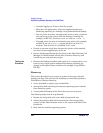
Disaster Recovery
Disk Delivery Disaster Recovery of an UNIX Client
Chapter 10 509
single user mode:
— boot -fl s to boot using already generated vmunix file
— boot -fi genvmunix -fl s to boot into the single user
mode with the generic kernel.
— If the system is already powered up and running, change from the
current run level to single-user mode by executing the following
command: init s
AIX — No action is required, because the alt_disk_install command,
used to prepare the auxiliary disk, ensures consistent disk image
without entering the state of minimal system activity.
Creating an
Auxiliary Disk
• If you want to work with the auxiliary boot disk, you have to prepare
it. Only one bootable auxiliary disk is required per site and platform.
This disk has to contain the operating system and network
configuration, and has to be bootable.
Preparing the
Backup
Specification
• Provide a Pre-exec script that performs the following:
— Collects all the necessary information about the environment and
puts it in an available location in case of a disaster recovery. It is
suggested to put it onto a different system which can be accessed
easily. The information should cover:
✓ Physical and logical storage structure of the storage
✓ Current logical volume structure (for example, on HP-UX,
using vgcfgbackup and vgdisplay -v)
✓ ServiceGuard configuration data, disk-mirroring, striping
✓ Filesystems and mountpoints overview (for example, on
HP-UX, using bdf or copy of /etc/fstab)
✓ System paging space information, for example, on HP-UX,
using the output of the swapinfo command
✓ I/O-structure overview (for example, on HP-UX, using
ioscan -fun and ioscan -fkn)
✓ Client network settings
— An emergency copy of the data can also be put into the backup
itself. If done so, the information has to then be extracted prior to
the actual recovery.


















